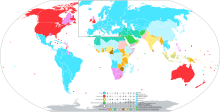Legal tradition
[2] The metaphor of a bee swarm has been used to understand the loosely organized nature of a legal tradition.
[8] Taking a more global view, in 1884, the Japanese comparatist Hozumi Nobushige divided the world's legal systems into Indian, Chinese, Islamic, Anglo-Saxon, and Roman families.
[9] Breaking with these early ad-hoc classifications, at the 1900 International Conference on Comparative Law in Paris, Gabriel Tarde called for the grouping of legal systems to be put on a taxonomic basis similar to the taxonomies that had been developed in linguistics and biology.
[12] In 1950, René David presented a division of the world's legal systems into Western, socialist, Islamic, Hindu, and Chinese groups.
[14] In 1961, Adolf Schnitzer divided the world's legal systems into five "circles" (Rechtskreise): primitive, ancient, Euro-American, religious, and Afro-Asian.
[16] However, in the same period that taxonomic approaches were being abandoned in comparative law, the legal origins theory became popular among economists.
[20] These can be further grouped into four global categories:[21] In Glenn's analysis, any particular country's laws will typically draw on multiple traditions.
Thus for example he analyzes the law of the People's Republic of China as a layering of Confucian and Western traditions.


